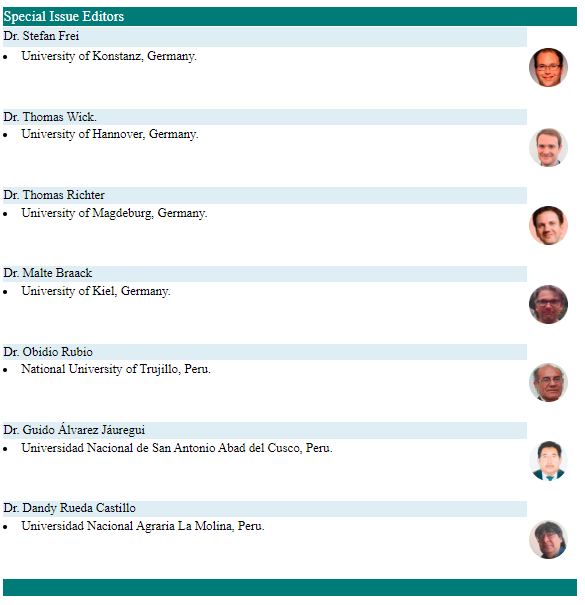Fundamental response in the vibration control of buildings subject to seismic excitation with ATMD
DOI:
https://doi.org/10.17268/sel.mat.2023.01.13Palabras clave:
Earthquake, control, vibrating system, fundamental matrix solution, LQR problemResumen
The linear quadratic regulator for vibration systems subject to seismic excitations is discussed in his own physical newtonian space as a second-order linear differential system with matrix coefficients. The linear quadratic regulator leads to a fourth-order system and second-order transversality conditions. Those systems are studied with a matrix basis generated by a fundamental matrix solution.
Citas
Murty C, Goswami R, Vijayanarayanan A, Mehta V. Earthquake Behaviour of Buildings, Gujarat State Disaster Management Authority. Gujarat, India. 2002.
Datta T. A state-of-the-art review on active control of structures. ISET Journal of Earthquake Technology. 2003; 40(1):1–17.
Ikeda Y. Active and semi-active control of buildings in japan. Journal of Japan Association for Earthquake Engineering. 2004; 4(3).
Yang J, Long F, Wong D. Optimal control of nonlinear structures. Journal of Applied Mechanics. 1988; 55(4):931–938.
Mohammadi R, Ghamari H, Farsangi E. Active control of building structures under seismic load using a new nniform deformation-based control algorithm. Structures. 2021; 33:593–605.
Sabetahd R, Mousavi S, Poursorkhabi R, Mohammadzadeh A, Zandi Y. Response attenuation of a structure equipped with atmd under seismic excitations using methods of online simple adaptive controller and online adaptive type-2 neural-fuzzy controller. Computational Intelligence and Neuroscience. 2022.
Skelton R. Dynamic Systems Control. John Wiley. 1988.
Oshman Y, Inman D, Laub A. Square-root state estimation for second order large space structures models. Guidance Control Dynamics.1989; 12(5):698–708.
Ram Y, Inman D. Optimal control for vibrating systems. Mechanical Systems and Signal Processing. 1999; 13(6):879–892.
Claeyssen J. On predicting the response of non-conservative linear vibrating systems by using the dynamical matrix solution. Journal of Sound and Vibration. 1990; 140(1):73–84.
Claeyssen J, Canahualpa G, Jung C. A direct approach to second-order matrix non-classical vibrating equations. Applied Numerical Mathematics. 1999; 30(1):65–78.
Pereslavtseva O. Calculation of the characteristic polynomial of a matrix. Discrete Mathematics and Applications. 2011; 21(1):109–129.
Yang J, Akbarpour A, Ghaemmghami P. Instantaneous optimal control laws for tall buildings under seismic excitations. in: Tech. Report NCEER 87-0007, National Center for Earthquake Engineering Research. 1987
Yang J, Li Z. Instantaneous optimal control for linear, nonlinear and hysteretic structures: Stable controllers. in: Tech. Report NCEER-TR-91-0026, National Center for Earthquake Engineering Research. Buffalo. 1991.
Zhang J. Optimal control for mechanical vibration systems based on second-order matrix equation. Mechanical Systems and Signal Processing. 2002; 16(1):61–67.
Descargas
Publicado
Cómo citar
Número
Sección
Licencia
Derechos de autor 2023 Selecciones Matemáticas

Esta obra está bajo una licencia internacional Creative Commons Atribución 4.0.
Los autores/as que publiquen en esta revista aceptan las siguientes condiciones:
- Los autores/as conservan los derechos de autor y ceden a la revista el derecho de la primera publicación, con el trabajo registrado con la licencia de atribución de Creative CommonsAtribución 4.0 Internacional (CC BY 4.0) , que permite a terceros utilizar lo publicado siempre que mencionen la autoría del trabajo y a la primera publicación en esta revista.
- Los autores/as pueden realizar otros acuerdos contractuales independientes y adicionales para la distribución no exclusiva de la versión del artículo publicado en esta revista (p. ej., incluirlo en un repositorio institucional o publicarlo en un libro) siempre que indiquen claramente que el trabajo se publicó por primera vez en esta revista.
- Se permite y recomienda a los autores/as a publicar su trabajo en Internet (por ejemplo en páginas institucionales o personales) antes y durante el proceso de revisión y publicación, ya que puede conducir a intercambios productivos y a una mayor y más rápida difusión del trabajo publicado(Consultar: efecto del acceso abierto).













